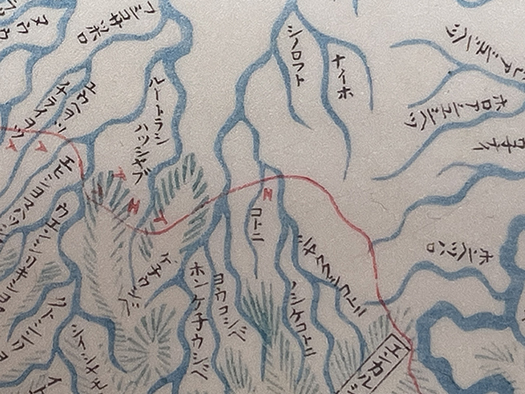
所用があって東京に来ておりますが、その所用の会場は有楽町ということで、午後からの日程前に皇居向かいに数年前に(移転)オープンした「静嘉堂文庫」を探訪。こちらは岩崎弥太郎・三菱財閥の収集した文化財などを収容していて、国宝の「曜変天目」などが有名。<曜変天目(茶碗)は、もと徳川将軍家所蔵であったものが、三代将軍・家光の時代、春日局を経て、後に淀藩主となる稲葉家へ伝えられたとされる。今日、世界中で現存する曜変天目(完形品)は、日本にある三碗のみ、京都・大徳寺龍光院、大阪・藤田美術館所蔵の各一碗と本碗で、すべてが国宝に指定されている。>
世田谷の多摩川近くに静嘉堂文庫はあり、いまも建物などはそのままということですが、美術館機能はこちらに移転してきている。前の場所には数回足を運んでいるけれど、今回はじめて訪問の機会が訪れたと思ったら、なんと「北海道」の命名者・松浦武四郎関連の展示が開催中だった。
ちょうどちょっと前に伊勢・松阪の松浦武四郎記念館や「生家」も探訪していたので、興味深く展示を拝見しておりました。撮影不可のものも多かったのですがこの写真は撮影OKの場所にあったものです。中央に位置する広場的なスペースの床にモザイクされた松浦武四郎の「北海道地図」。
ちょうどわが家のある「コトニ(琴似)」が中央にある地図の一部を写真に収めてみた。
周辺には今となってはわからない地名も多いのですが、ナイホは苗穂、シノロフトは篠路太、ハッシャブは発寒、さらにはフシコサッポロ(伏古札幌)という広域地名など、馴染みの強い地名を発見すると、東京都心とわが家の距離感が一気に近づいてくるような思いがしてくる(笑)。
こういう探訪旅ですが、ちょうど目的的テーマに絞ってきていまして、そういう意味ではまさか、東京の中心のこの場所でこういう出会いを経験できたのも、なにかの偶然の導きでしょうか。
松浦武四郎さんって、その生誕から生涯の終わりまで、非常にユニークな人生を送った人だとつくづく思いますね。ちょうど幕末〜明治という時代の大転換期にジャストフィットした人生だったように感じます。ちょっとズレていたら、大奇妙人とされてもふさわしい(笑)。
そういう破天荒系の人物が名付けた地名の土地に生きてきた人間として、共感できるものも多い。

で、美術館を出て有楽町の駅前まで徒歩移動。途中は日本有数のビジネス街だけれど、休日には車両通行も制限されて歩行者専用のテラス通りに変貌している。写真は有楽町の駅前での「空中庭園」。すぐとなりを新幹線がさかんに通り過ぎていくのですが、みどりのなかからのんびりとスマホいじりさせていただいていました。あ、料金はかからない、無料公開の場所です。
English version⬇
Takeshiro Matsuura’s “Hokkaido” Naming and Exploration Diagrams
Matsuura’s exhibition is being held in front of the Imperial Palace. The exhibition is currently being held in front of the Imperial Palace. The exhibition is open to the public.
I have some business in Tokyo, and since the venue for that business is Yurakucho, I visited the Seikado Bunko, which opened (relocated) a few years ago across the street from the Imperial Palace before my afternoon schedule. The Seikado Bunko houses cultural properties collected by Yataro Iwasaki and the Mitsubishi Zaibatsu, and is famous for such items as the National Treasure “Yohhen Tenmoku” (tea ceremony utensil). <It is said that the Yohantenmoku (tea bowl) originally belonged to the Tokugawa Shogun’s family, but during the reign of the third Shogun, Iemitsu Iemitsu, it was passed down through Kasuga Bunko to the Inaba family, who later became the lords of the Yodo domain. Today, there are only three surviving examples of yohen tenmoku (perfect form) in the world, one each from the Ryukoin temple of Daitokuji in Kyoto and the Fujita Museum of Art in Osaka, as well as this bowl, all of which are designated as national treasures. > >
Seikado Bunko is located near the Tamagawa River in Setagaya, and although the building and other facilities are still intact, the museum functions have been moved here. Although I have visited the former location several times, this was my first time to visit the Seikado Bunko, and to my surprise, an exhibition related to Takeshiro Matsuura, the man who named Hokkaido, was being held there.
I had just visited the Takeshiro Matsuura Memorial Museum and his birthplace in Matsuoka, Ise, a short while ago, so I was very interested in the exhibition. Many of the exhibits were not allowed to be photographed, but this photo was taken at a place where photography was allowed. This is a mosaic of Takeshiro Matsuura’s “Map of Hokkaido” on the floor of the plaza-like space in the center of the building.
I took a picture of a part of the map with “Kotoni (Kotoni),” where our house is located, right in the center.
There are many place names in the vicinity that I do not recognize today, but when I discover place names that are strongly familiar to me, such as Naiho for Naebo, Shinoroft for Shinorota, Hashabu for Hassamu, and even the broader place name Fushiko Sapporo (Fushiko Sapporo), I feel as if the distance between central Tokyo and my home is quickly approaching (laughs).
In this sense, it was probably a coincidence that I was able to experience this kind of encounter in the center of Tokyo.
Takeshiro Matsuura led a very unique life from his birth to the end of his life. It seems to me that his life was just in time for the great transition from the end of the Edo period to the Meiji period. If he had been a little off, he would have been considered a great eccentric (laughs).
As a person who has lived in a place named after such a maverick, I can relate to many things.
So, I left the museum and walked to Yurakucho Station. The area along the way is one of the most famous business districts in Japan, but on holidays, vehicular traffic is restricted and the area is transformed into a pedestrian-only terrace street. The photo shows the “hanging garden” in front of Yurakucho Station. The Shinkansen bullet train was passing right next to me, and I was able to relax and play with my phone from the midst of the greenery. Oh, there is no charge, and the place is open to the public free of charge.
Posted on 5月 12th, 2024 by 三木 奎吾
Filed under: 出張&旅先にて







コメントを投稿
「※誹謗中傷や、悪意のある書き込み、営利目的などのコメントを防ぐために、投稿された全てのコメントは一時的に保留されますのでご了承ください。」
You must be logged in to post a comment.